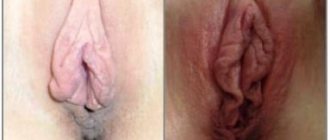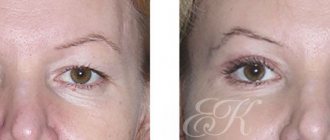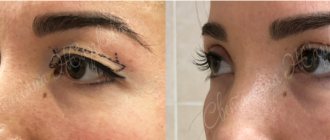Cosmetic eye surgery solves many aesthetic problems associated with injuries, age-related changes, anatomical features of the face, and painful conditions that cause changes in the contours of the lower or upper eyelid. Let's find out what types of cosmetic eye surgeries exist and to whom they are indicated.
Age-related changes in the skin in the eyelid area lead to facial asymmetry, impair vision (if the skin of the upper eyelid hangs over the eye), create difficulties when applying makeup and change appearance. Fortunately, the characteristic signs of youth - an open, clear look with a clear contour - can be restored by deciding on a special cosmetic procedure, the purpose of which is to eliminate acquired defects in the skin of the eyelids.
Such operations are classified as cosmetic surgery. It is believed that there can be no indications for them, because appearance is corrected at the request of the people themselves, but still, the fight against aging in many cases means a significant improvement in the quality of life. Such operations may be recommended for patients suffering from age-related changes. Who can have surgery?
What does the shape of the eye depend on?
From genetics, of course. Thus, narrow, squinted eyes are a characteristic feature acquired by Asian nomads during evolution. It is necessary in order to effectively protect the eyeball from fine dust entering it. And among some northern Asian peoples, this feature does not allow the snow sparkling in the sun to “blind” a person.
The differences between the Asian type of eye shape and the European one are:
- lower location of external corners in relation to the upper ones;
- some swelling caused by fat accumulation in the upper eyelid;
- the presence of a small additional fold of skin on the upper eyelid;
- the presence of a specific fold in the inner corner of the eye, called the epicanthus.
What are the most effective eye plastic surgery methods?
To eliminate cosmetic defects in the area around the eyes, classical surgical techniques and laser technologies can be used. Often combined methods are used to obtain the maximum possible anti-aging effect. The most popular operation is blepharoplasty, during which fatty hernias are removed, and, if necessary, excess skin. The so-called “Asian eyelids” are corrected by creating a crease in the upper eyelid.
What are the types of cosmetic and plastic surgery operations in the eye area:
- traditional blepharoplasty - performed with an incision in the subciliary area, excess skin is excised, sutures are applied;
- transconjunctival blepharoplasty - performed through the inner surface of the eyelid, without removing excess skin, only the fatty hernia is removed, therefore the operation is recommended for young patients whose defects are associated with the anatomical structure, with a hernia of the eyelid or slight ptosis;
- laser blepharoplasty - during the operation, a laser beam is used, which allows for a thinner incision, so the stitches are thin and invisible, and swelling and hematomas are less pronounced.
Transconjunctival blepharoplasty has many advantages, including: a short rehabilitation period, no need to remove sutures, since the incisions are closed with self-absorbable threads, etc. Unfortunately, this technique does not allow one to cope with age-related changes.
How to make your eyes bigger?
Obviously, any independent attempts to increase the shape of the eyes are doomed to failure in advance. All of the above differences are of an anatomical nature, and therefore no conservative measures can change them. Of course, there is always the option of using cosmetics wisely. Properly selected and applied shadows, as well as other makeup techniques, will help make your eyes appear larger. But, of course, this is not a solution to the issue, but only a temporary disguise. The only effective way to increase the shape of the eyes is plastic surgery, which will actually make the palpebral fissure larger.
Operation to create an “eastern” eye shape
In order to create a characteristic tilt of the eyes, you need to slightly raise the outer corner. The look gets a touch of exoticism. Usually people call this eye shape “cat” or “oriental”. This type of plastic surgery is suitable for large and somewhat protruding eyes.
Changing the eye shape by surgery is a complex procedure that requires a lot of experience from the doctor. Contact SOHO CLINIC, and our specialists will help you achieve the desired effect without harm to your health. We provide an individual approach to each client. Fulfill your dreams of the desired appearance, and it will not only make you more attractive, but also give you self-confidence. Make an appointment today. The doors of SOHO CLINIC are open to patients 7 days a week and 24 hours a day.
How is this operation carried out?
The areas of connective tissue that narrow the eye during its Mongoloid shape are called canthuses. Consequently, an operation that corrects the shape and size of such areas will be called canthoplasty. This intervention is a special case of blepharoplasty - changing the shape and size of the upper or lower eyelids.
The most common type of canthoplasty is lateral. But with its help, surgeons at our clinic mainly correct problems associated with age-related drooping of the outer corners of the eyes. But surgery to remove the epicanthus to enlarge the eyes requires another, less common approach - medial canthoplasty. In addition to eliminating the epicanthus itself, such an intervention may also include:
- correction of the proportions of the eyelids, which changes the shape of the palpebral fissure;
- changing the direction of the eye incision by raising its outer corner compared to the inner one;
- removal of excess fat deposits and excess skin folds in the tissues of the upper eyelid.
The need to correct certain elements depends on the severity of Mongoloid facial features. In each specific case, SM-Plastic specialists individually assess a person’s appearance and make a decision on the degree of intervention required, based on their rich practical experience.
The operation itself can be performed under either local or general anesthesia, which is determined by its volume. The total duration of the correction is usually about an hour.
Individual consultation
Thank you for your application. Our operator will contact you from 8:00 to 22:00 Applications received after 22:00 will be processed the next day.
Are there any contraindications to plastic surgery on the eyes?
If the health of a person who has decided to undergo cosmetic surgery is normal, then contraindications will not prevent him from enjoying the results of such a procedure. Difficulties in obtaining permission to perform surgical intervention may arise if:
- heart and kidney diseases;
- autoimmune disorders and diabetes;
- oncological diseases;
- problems with the thyroid gland;
- bleeding disorders;
- intolerance to anesthesia.
Before surgery, the patient must undergo a comprehensive examination to exclude inflammation and possible complications during surgery. Typically such an examination includes:
- general and biochemical blood test - the results allow you to obtain accurate data on blood clotting, the presence of an inflammatory process, and the body’s readiness to resist infections;
- urine analysis - allows you to identify pathological processes in the body, infectious diseases, inflammation, and inform about disturbances in the production of thyroid hormones;
- fluorography, cardiogram, consultation with an anesthesiologist;
- consultation with an ophthalmologist.
In order for the result of the operation to meet expectations, it must be carried out in a well-equipped, modern clinic. Also, the result is largely influenced by the surgical technique and the qualifications of the surgeon.
What happens after the intervention?
On the first day after surgery, cold compresses can be used on the skin around the eyes - they will help to quickly remove swelling of the tissues. On days 5-6, specialists at the SM-Plastika clinic will remove the sutures, and finally, all the consequences of the correction, as a rule, disappear after about two weeks. During this entire time, you need to limit physical activity and try to bend over and turn your head sharply as little as possible. Of course, during this period you should not wear glasses or contact lenses, or apply any cosmetics to your eyes. And for the next month you should avoid any exposure to elevated temperatures on the eye area and face as a whole.
All manipulations during this operation are carried out by SM-Plastic specialists in the natural folds of the skin. Thanks to this, after the final healing of the tissue, all visible traces of the intervention will disappear, and the eyes will look absolutely natural. The full result of this correction will become obvious in about 1.5–2 months. An important advantage of canthoplasty is that its result - an enlarged, Caucasian eye shape - will last for the rest of your life.
If you would like to receive more information about increasing the size of the eyes at the SM-Plastic clinic and make an appointment with our plastic surgeons, contact us by phone: +7 (495) 777-48-05.
Preparation for eye plastic surgery, possible complications
Preparation begins two weeks before surgery. Patients undergo the necessary tests, they are warned that they need to give up alcohol, smoking, and also limit the intake of certain medications and vitamins. The operation of blepharoplasty is considered simple, but the result depends on the experience of the surgeon, who, due to inexperience, may perform an incomplete correction, in which case a repeat operation will be required.
Swelling and hematomas are not complications, as they disappear within a few days, but strong, incessant lacrimation may indicate that the nasolacrimal ducts have been narrowed due to an improperly healed wound. There are cases when, during surgery, the muscle is damaged and it can no longer support the eyelid, causing it to droop. A complication is also considered to be non-closure of the upper and lower eyelids (if during the operation more skin was cut off than necessary), when the eyes of a person who has undergone a rejuvenation procedure remain half-open during sleep. All these shortcomings can be eliminated by repeated surgery.
Endoscopic blepharoplasty of the lower and upper eyelids
Endoscopic blepharoplasty is a modernized method of eyelid lift (analogous to the classic version with some modifications). This procedure is primarily suitable for patients under 45 years of age (as it is not intended to address large defects or significant signs of aging).
The main advantages of the technique:
- Lowest level of injury
- Minimum recovery period
- No contraindications (with a few exceptions)
How is endoscopic blepharoplasty performed:
- A special device is used - an endoscope equipped with a small camera that transmits video to the doctor’s monitor.
- A microscopic incision is made in the correction area through which special instruments are inserted.
- The doctor carefully corrects imperfections and provides a lifting effect in the eyelid area
Due to the small incision used, there are no scars left on the face after surgery.
Thread blepharoplasty
Thread blepharoplasty is carried out by introducing special gold threads into the skin, which in turn provide a lifting effect for the treated area. The main feature of the procedure is the effect of golden threads.
Results of the thread method:
- Stimulation of metabolism in the eyelid area
- Significant influx of oxygen into skin tissue
- Skin nutrition and hydration are significantly improved
- Microcirculation is restored
All this is achieved due to the effect of gold on the biological tissues of the facial skin. This procedure cannot be called therapeutic, because... it is not intended to solve significant problems in the lower and upper eyelids. But it is excellent for preventing aging, as well as for eliminating minor age-related changes. Can be effectively used in combination, for example with laser rejuvenation .
Preparatory stage
Non-surgical blepharoplasty is performed on an outpatient basis ; it does not require going to the clinic for a long time. The procedure itself is preceded by an examination by a dermatologist, during which the doctor will assess the condition of the eyelids and draw up an individual treatment and correction plan. What you need to do before the non-surgical blepharoplasty procedure:
- A blood test, coagulogram and ECG are performed to assess the patient’s general condition
- Based on the data obtained from the tests, the doctor decides whether to admit the patient to the procedure.
- Computer modeling is necessary to generate a preliminary result, according to the client’s preferences and specialist recommendations.
A preliminary assessment of the condition of the eyelids takes into account: the tone of the cartilage tissue, the presence of excess skin and the depth of wrinkles.
Cost of epicanthoplasty at IPH
Removal of epicanthus in our Institute costs from 44,000 rubles. depending on the volume of intervention. You can find out the exact price at a free consultation with a plastic surgeon. The cost includes all preliminary tests, anesthesia, hospital stays, suture removal, and specialist consultations. No additional fees or unexpected expenses.
Take advantage of our installment plan and enjoy your new look today!
Attention! All aesthetic plastic surgeries and most cosmetic procedures are strictly contraindicated for pregnant and lactating women. We also do not perform surgical interventions on people whose weight exceeds 110 kg.
Hardware blepharoplasty
People often confuse hardware blepharoplasty with laser. Hardware techniques are based on tightening the facial skin using various procedures. Increased collagen and elastin, as well as rapid improvement of skin tissue are the main advantages of this technique.
The main procedures included in the group of hardware blepharoplasty are described below:
- Non-surgical blepharoplasty using plasma current. The essence of the procedure is the effect of electric current on the eyelid area, which causes heating of the skin, improves metabolism and the appearance of the skin of the eyelids. The main feature of this procedure is the targeted impact of low-power current - this allows you to not injure the skin, and the patient does not feel pain.
- Ultrasonic smas lifting is the effect of ultrasonic waves on the skin of the eyelids. The peculiarity of the procedure is the penetration of waves into depth, which allows you to achieve a good lifting effect in all areas. Restoring the elasticity of collagen fibers is another advantage of this technique.
- Thermage is a procedure using high-frequency radio waves. Requires the use of local anesthesia as it is not painless. The process is similar to the use of plasma current, only in this case the skin is heated more actively and a larger area is affected. The effectiveness of this procedure is at a high level, but rehabilitation leaves much to be desired.
Hardware blepharoplasty is often called electroblepharoplasty . Despite the fact that laser technologies have stepped forward and now have several undeniable advantages over electrical devices, many people continue to use these procedures. Such procedures are best used in comprehensive facial rejuvenation.
Indications
In most cases, there are no medical reasons required for blepharoplasty. As a rule, the surgeon makes the decision on the appointment, guided by the wishes of the patient himself. Indications for surgery are rather aesthetic:
- the presence of wrinkles,
- drooping eyelids,
- drooping corners of the eyes,
- folds on the skin,
- excess skin, etc.
- bags under the eyes,
- tear troughs and so on.
In rare cases, certain defects may be caused by congenital characteristics, the result of injury, or a hereditary factor. Provided that such a defect affects the state of health, surgery may be prescribed for medical reasons. Usually this prescription is given by an ophthalmologist. This is possible, for example, in the case of a drooping eyelid, which obscures normal vision and affects vision.
Contraindications
Blepharoplasty is not suitable for every patient. Despite its simplicity, eyelid surgery still remains a surgical intervention, and therefore has a number of contraindications characteristic of all operations:
- diabetes,
- problems with blood clotting,
- diseases of the cardiovascular system,
- infection or inflammation
- acute stage of chronic disease,
- oncology.
Blepharoplasty is not prescribed to patients with eye and facial skin diseases. Conjunctivitis, dry eye syndrome, and high intraocular pressure will be a reason to refuse correction. If the disease is temporary and curable, surgery is possible after eliminating the contraindication. In case of persistent diseases or problems, plastic surgery is, unfortunately, excluded.











